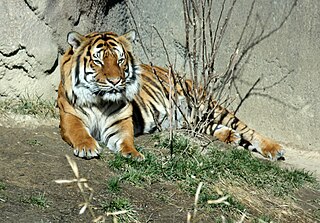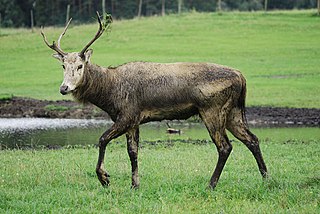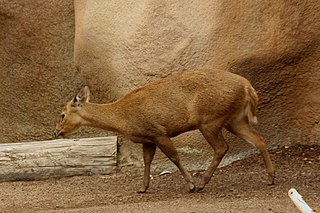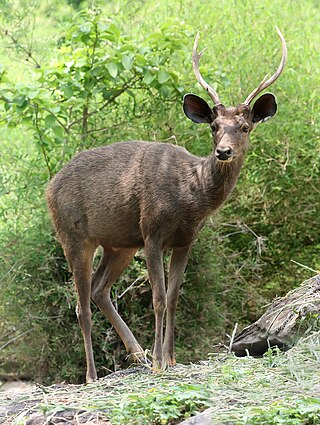
The sika deer, also known as the Northernspotted deer or the Japanese deer, is a species of deer native to much of East Asia and introduced to other parts of the world. Previously found from northern Vietnam in the south to the Russian Far East in the north, it is now uncommon except in Japan, where the species is overabundant.

The sambar is a large deer native to the Indian subcontinent, South China and Southeast Asia that is listed as a vulnerable species on the IUCN Red List since 2008. Populations have declined substantially due to severe hunting, local insurgency, and industrial exploitation of habitat.

The chital or cheetal, also known as the spotted deer, chital deer and axis deer, is a deer species native to the Indian subcontinent. It was first described and given a binomial name by German naturalist Johann Christian Polycarp Erxleben in 1777. A moderate-sized deer, male chital reach 90 cm (35 in) and females 70 cm (28 in) at the shoulder. While males weigh 70–90 kg (150–200 lb), females weigh around 40–60 kg (88–132 lb). It is sexually dimorphic; males are larger than females, and antlers are present only on males. The upper parts are golden to rufous, completely covered in white spots. The abdomen, rump, throat, insides of legs, ears, and tail are all white. The antlers, three-pronged, are nearly 1 m long.

The Javan rusa or Sunda sambar is a large deer species native to Indonesia and East Timor. Introduced populations exist in a wide variety of locations in the Southern Hemisphere.

The Malayan tiger is a tiger from a specific population of the Panthera tigris tigris subspecies that is native to Peninsular Malaysia. This population inhabits the southern and central parts of the Malay Peninsula and has been classified as critically endangered on the IUCN Red List since 2015. As of April 2014, the population was estimated at 80 to 120 mature individuals with a continuous declining trend.

The Sri Lankan leopard is a leopard subspecies native to Sri Lanka. It was first described in 1956 by Sri Lankan zoologist Paules Edward Pieris Deraniyagala.

The Cervinae or the Old World deer, are a subfamily of deer. Alternatively, they are known as the plesiometacarpal deer, due to their ankle structure being different from the telemetacarpal deer of the Capreolinae.

Deer hunting is hunting for deer for meat and sport, an activity which dates back tens of thousands of years. Venison, the name for deer meat, is a nutritious and natural food source of animal protein that can be obtained through deer hunting. There are many different types of deer around the world that are hunted for their meat. For sport, often hunters try to kill deer with the largest and most antlers to score them using inches. There are two different categories of antlers. They are typical and nontypical. They measure tine length, beam length, and beam mass by each tine. They will add all these measurements up to get a score. This score is the score without deductions. Deductions occur when the opposite tine is not the same length as it is opposite. That score is the deducted score.

The Philippine deer, also known as the Philippine sambar or Philippine brown deer, is a vulnerable deer species endemic to the Philippines. It was first described from introduced populations in the Mariana Islands, hence the specific name.

The Calamian deer, also known as Calamian hog deer, is an endangered species of deer found only in the Calamian Islands of Palawan province in the Philippines. It is one of three species of deer native to the Philippines, the other being the Philippine sambar and the Visayan spotted deer.

The wildlife of Cambodia is very diverse with at least 162 mammal species, 600 bird species, 176 reptile species, 900 freshwater fish species, 670 invertebrate species, and more than 3000 plant species. A single protected area, Keo Seima Wildlife Sanctuary, is known to support more than 950 total species, including 75 species that are listed as globally threatened on the IUCN Red List. An unknown amount of species remains to be described by science, especially the insect group of butterflies and moths, collectively known as lepidopterans.

The Sri Lankan sambar or Indian sambar - it is also spelt "sambhur" or "sambur" - ගෝනා (gōṇā) in Sinhala, is a subspecies of the sambar that lives in India and Sri Lanka. This subspecies is one of the largest sambar subspecies, with the largest antlers both in size and in body proportions. Large males weight up to 270–280 kg. Sambar live in both lowland dry forests and mountain forests. Large herds of sambar roam the Horton Plains National Park, where it is the most common large mammal.

Deer Cave, located near Miri, Sarawak, Malaysia, is a show cave attraction of Gunung Mulu National Park. It was surveyed in 1961 by G. E. Wilford of the British Borneo Geological Survey, who predicted that Mulu would yield many more caves in the future. The cave, which is also known as Gua Payau or Gua Rusa by the local Penan and Berawan people, is said to have received its name because of the deer that go there to lick salt-bearing rocks and shelter themselves.

The Formosan sambar is a subspecies of the sambar found in Taiwan. It is the largest native herbivore there. Its fur color changes with season to provide camouflage. It is yellowish-brown in the summer and dark brown in the winter.

Rusa is a genus of deer from southern Asia. They have traditionally been included in Cervus, and genetic evidence suggests this may be more appropriate than their present placement in a separate genus.
Tanintharyi National Park is a proposed national park in Myanmar's Tanintharyi Region that was supposed to cover an area of 2,072 km2 (800 sq mi) of mangrove and evergreen forests at an elevation from sea level to 1,490 m (4,890 ft). It was proposed in 2002. Wildlife species in this area include Asian elephant, sambar deer, Malayan tapir, Indian muntjac, and leopard.
Australia has a population of about 25 million, with recent survey estimating between 200,000 and 350,000 recreational hunters in the country. There are around 5.8 million legally owned guns in Australia, ranging from airguns to single-shot, bolt-action, pump-action, lever-action or semi-automatic firearms.
Kyaikhtiyo Wildlife Sanctuary is a protected area in Myanmar stretching over 156.21 km2 (60.31 sq mi). It covers evergreen and mixed deciduous forests an elevation of 50–1,090 m (160–3,580 ft) in Kyaikto Township. It was established in 2001 to conserve the biodiversity around the Kyaiktiyo Pagoda, a famous pilgrimage site in Mon State.
Phu Pha Daeng Wildlife Sanctuary is a wildlife sanctuary in Lom Sak District of Thailand's Phetchabun Province. The sanctuary covers an area of 235 square kilometres (91 sq mi) and was established in 1999.
















